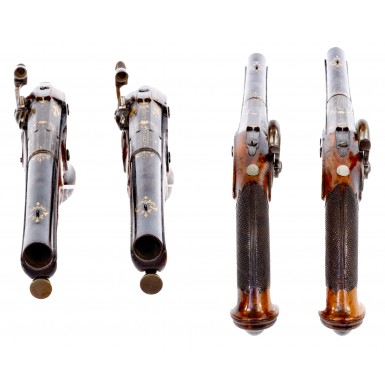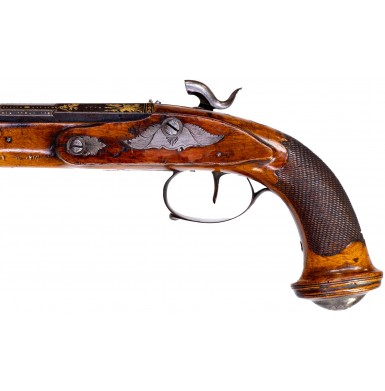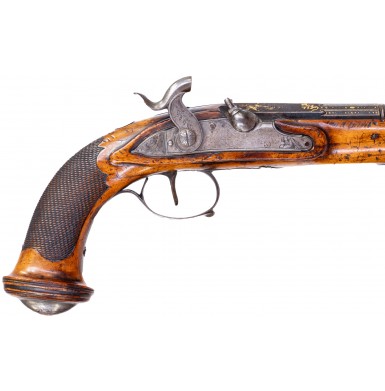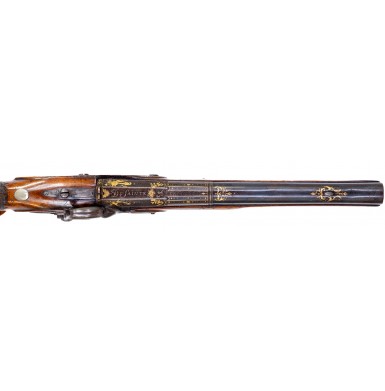Wonderful Pair of Blued and Gilt Late 18th Century Percussion Altered French Officers Pistols by DeSainte of Versailles
- Product Code: FHG-3542
- Availability: In Stock
-
$3,750.00
Pierre DeSainte (c1719-c1803) was the son of noted French gunsmith Orléans DeSainte who worked in Loiret and Paris circa 1720 to 1750. Pierre most likely initially studied under his father, although apprenticeships were often served under the watchful eye of another master gunsmith who was not a close family member. By 1747 DeSainte was a “Master Gunmaker, Crossbow Maker and Fireworker” (Stockel) and by 1763 he had relocated to Versailles from Paris and was appointed Gunmaker to the Court of French King Louis XVI. In 1769 he became mater of the Paris Gunmaker’s Guild and 1788 was appointed the Master of the Manufacture d’Armes de Versailles. That same year, Nicolas Nöel Boutet, who would become one of the most famous gunmakers in the world, married DeSainte’s daughter. With this marriage, Boutet became by extension Gunmaker to the King and Dauphin. In 1791 DeSainte was granted “Logement” (accommodations) in the Louvre, which was officially made a public museum that year by declaration of the National Constituent Assembly, making it a “place for bringing together monuments of all the sciences and arts”. Both DeSainte and Boutet survived the French Revolution of 1792, while many supporters of the court and court appointees did not. DeSainte remained in charge of the Versailles arms manufactory until his death, after which Boutet ascended to the position. Boutet would also go on to take over the Manufacture de Liege in 1804 in the name of his son Pierre Nicolas Boutet, who was no doubt named for his grandfather Pierre DeSainte. During his working career DeSainte produced many very high-grade arms for both the Royal Court of King Louis XVI as well as for courtiers and ranking military commanders. Some of the arms were presentation grade, sometimes referred to as arms of “reward”. The quality of DeSainte’s high grade engraved and gilt decorated arms likely provide inspiration to the younger Boutet who would go on to become one of the most famous gunsmiths in the world.
The Pair of Pierre DeSainte Holster Pistols offered for sale here could be considered very high-grade officer’s pistols or possibly even Pistols of Reward and likely date from the 1790s, as he would not utilize the “a Versailles” mark until circa 1788. The pistols were originally manufactured in flint and were expertly altered to percussion during their working like, circa 1830-1840. The form of the pistols is one that would eventually be recognized as an official officer’s pistol pattern during first quarter of the 19th century, but at the time of their manufacture there was no official pattern for officer’s holster pistols. Like the officers of most European countries, as well as England and the United States, French officers were to provide their own uniforms and small arms. These were typically based upon specified patterns, with embellishments limited only by the officer’s budget. If these pistols were purchased by an officer, they certainly went to one that had both rank and wealth. Otherwise, they were almost certainly produced for presentation to a particularly appreciated officer.
The guns measure nominally 16” in overall length with pinned three-stage slightly swamped blued barrels that go from octagonal at the breech to hexadecagonal to round, with baluster turned rings at the transition to round. The guns are steel mounted with lightly engraved steel triggerguards, butt caps, and side plates. The stocks are of European hardwood, likely walnut, with some reasonable figure and the curved grips are neatly checkered with flowing scalloped boarders. The forends are full length and brass tipped wooden ramrods are retained by a single steel thimble and an entry pipe. The flat faceted stepped locks were likely originally color casehardened and have pointed tails. They are lightly engraved with simple foliate motifs at their fronts and rears. The locks are otherwise unmarked and measure 4 3/8” in length. The pistols were originally produced in flint and were expertly altered to percussion in a classic French style with brazed bolsters over the original flintlock touchholes, all external flint battery parts removed, the accompanying holes filled, and new percussion hammers added. The hammer necks are lightly engraved with simple foliate decorations ensuite with the locks. The blued barrels are profusely decorated with gilt highlighted engraved patterns on the eight and sixteen sided portions of the breech and lesser decorations just forward of the baluster turned ring transition and around the front sight blades on the round portions of the barrels. The breeches feature panoplies and trophies of arms along with foliate themes and patterns as well as dots and geometric decorations. The top flats of the breeches are marked DESAINTE with the top flat of the hexadecagonal section marked A VERSAILLES. The decorations on the round portion of the barrel consist of foliate wreaths and frames. The pistols are equipped with fixed notch rear sights at the rear of the breeches and simple blade front sights about 1 ¾” from the muzzles. The pistols are nominally 16mm (about .63 caliber) and have smooth bores. The pistols retain a pair of what appear to be original brass tipped wooden ramrod with one of the rods including a steel worm on the reverse end and the other rod not so equipped.
Both pistols remain in FINE condition and retain much of their original finish on their barrels. The barrels both retain between 30% and 40% of their original bright blue, which has flaked and faded leaving the balance of the barrels with a really attractive plum brown patina. The pistols retain much of their gold gilt decorations as well, with one gun retaining noticeably more gold than the other. The barrels show scattered freckles of surface oxidation and some scattered small aeras of minor surface roughness, but are free of any real pitting, although some scattered pinpricking is present here and there. As noted, the locks were likely color casehardened and now both have lightly oxidized and slightly mottled pewter gray patinas with some scattered minor age discoloration. The steel furniture has the same lightly mottled and oxidized pewter gray patina as found on the locks. Both locks remain mechanically fine and are crisp and tight, operating as they should. The bores of the pistols rate about VERY GOOD+ and are primarily bright with some scattered light to moderate oxidation as well as some lightly scattered pitting. The stocks of the pistols are fine and crisp as well. They retain sharp edges and lines, and the checkering of the grip remains well defined. The stocks are both full-length, solid and free of any breaks, cracks or repairs. The stocks show a moderate number of scattered bumps, dings and mars but both remain in very nice condition.
Overall, these are a really wonderful pair of Percussion Altered Late 18th Century French Officer’s Pistols by DeSainte of Versailles. As noted, these may more correctly be termed “Pistols of Reward”, but it would be difficult to prove (or disprove) that assertion. Both guns are original, complete and correct in every way and are a truly gorgeous set of 1790s guns that remained in use long enough to altered to percussion during the second quarter of the 19thcentury. The guns almost certainly date from right around the period of the French Revolution and would be equally at home in a collection of Louis XVI era arms as those of the First Republic. These stunning guns will be a fine addition to any serious collection of French military arms and were produced by the first of the Master Gunmakers to run the Versailles manufactory. Considering their condition and eye appeal these are really a “lot of guns for the money” as a good friend of mine likes to say.
Tags: Wonderful, Pair, of, Blued, and, Gilt, Late, 18th, Century, Percussion, Altered, French, Officers, Pistols, by, DeSainte, of, Versailles















